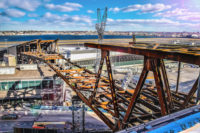A 14,000-sq-ft installation of a proprietary paving material that was combined with recycled rubber tires wrapped up last month at Yellowstone National Park, marking the largest undertaking of its kind to date in the three-year project near Old Faithful.
Crews, including park and Michelin volunteers with contractor KBI, laid the porous pavement for a 9-ft-wide, 2-in.-thick path as part of an approximately $200,000 contract with Yellowstone Forever, the official non-profit organization working with Yellowstone National Park. The fourth phase of the project brings the total amount of pavement for walking paths to 34,000 sq ft.
The work is only done during the off-peak season, and “the conditions need to be right to lay the pavement,” says Jeff Augustin, senior director of park projects with Yellowstone Forever.
The porous material allows rain and snow runoff to seep through the footpaths and replenish the natural water basin, and it doesn’t leach pollutants into the ground or break apart like asphalt, officials say. “Asphalt chunks are kicked or thrown into the pools” by tourists, affecting the natural composition of the water, notes Augustin.
KBI developed the first iteration of the Flexi-Pave product in 2001, says company CEO Kevin Bagnall. “This pavement was developed as a next-generation infrastructure material for water conservation. As urbanization increases, population density increases. Waste streams increase. Tire waste increases. But fresh water is not increasing.”
KBI and Michelin, which has donated about $300,000 worth of tires and maintenance expertise to the park’s vehicles and equipment since 2007, suggested to Yellowstone Forever the use of worn-out tires—with more than 100,000 miles traveled—and Flexi-Pave. The first phase, completed in 2015, included 900 end-of-life Michelin tires for 6,400 sq ft of footpath. About 7,600 tires have been used for the project in total.
According to Michelin and KBI, the pavement is heat-tolerant and durable, allowing 3,000 gal of groundwater to pass per square foot. Rubber granules and stone are held together by a polymer binding agent that is inert when cured. The open-pore design allows for up to 4,000 cu in. of water per hour to pass through—a key factor, since the geysers and springs of the park are volatile, often bursting through existing pavement.
The rubber granules also render the pathways less slippery and thus ADA-compliant, according to KBI. The pavement uses three tires for every 10 sq ft of material installed and is not susceptible to freeze-thaw conditions, the company claims.
“It passively cleans the water and produces bio-bacteria that eats phosphorus and other harmful elements,” says Bagnall. “The binding agent cures with moisture, in 24 hours.”
Park officials are assessing the pavement long term. “We are continually looking for permeable products. We are looking at all kinds of materials,” says Lynn Chan, landscape architect with the National Park Service. One concern with Flexi-Pave is that “we have a huge UV factor, and plastic degrades,” she says. “The binder is susceptible.” Bagnall agrees that “the temperature swings are unique here.”
The pavement is about 2.5 times more expensive per square inch compared to asphalt, Bagnall says. After its debut, “It took at least 10 years to get engineers to buy off,” he says. “We needed testimonials and proof of its return on investment.” Several states and municipalities are using the product, and other national parks are interested, he adds.






Post a comment to this article
Report Abusive Comment